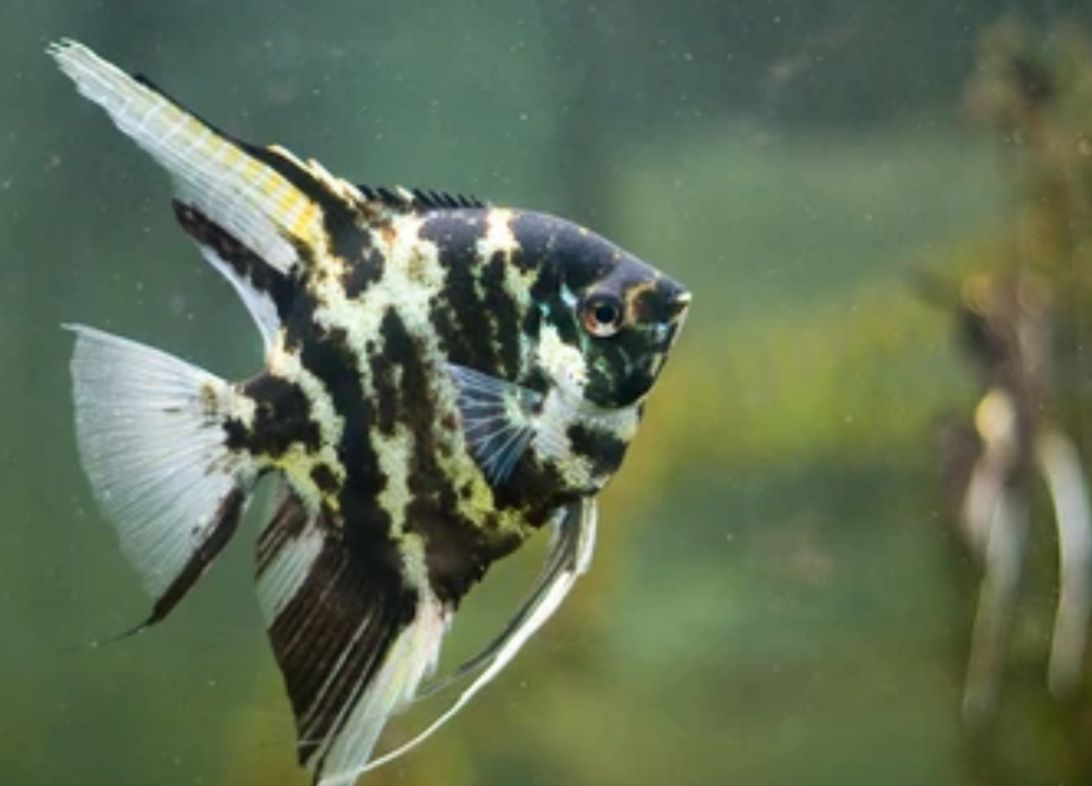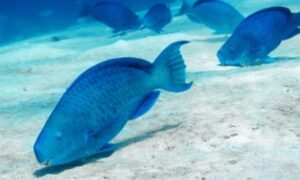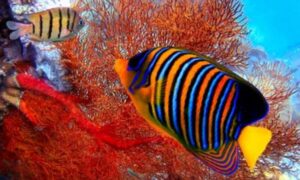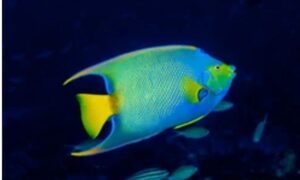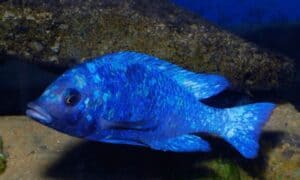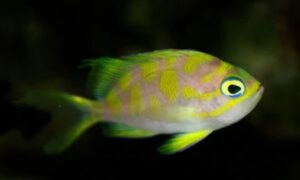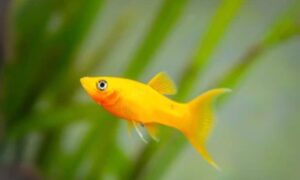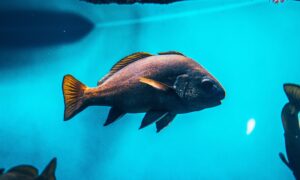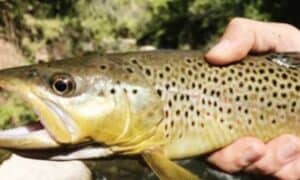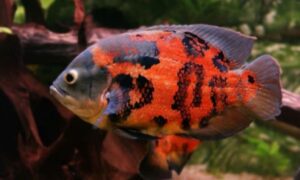Marble angelfish is a cichlid and a freshwater fish. Marble angelfish has a beautiful color pattern. They have three subcategories Gold marble angelfish, Black marble angelfish, and Blue marble angelfish.
Its scientific name is Pterophyllum. It’s basically a tiny genus of freshwater fish coming from the family of Cichlidae.
Table of Contents
The appearance of Marble Angelfish
Marble angelfish show beautiful color patterns. When looking at their subcategories, Gold varieties have blackish and whitish but most of them are in gold colors.
On the other hand, black marble has more black colors and markings on its body. And similarly, blue marble has a bluish tint on its body.
Coming to their size, their length is 6 inches with their height, starting from their dorsal fin’s tip to the end of their anal fin and then reaching up to 8-10 inches. The veil species have long fins and due to that, they can have much longer heights.
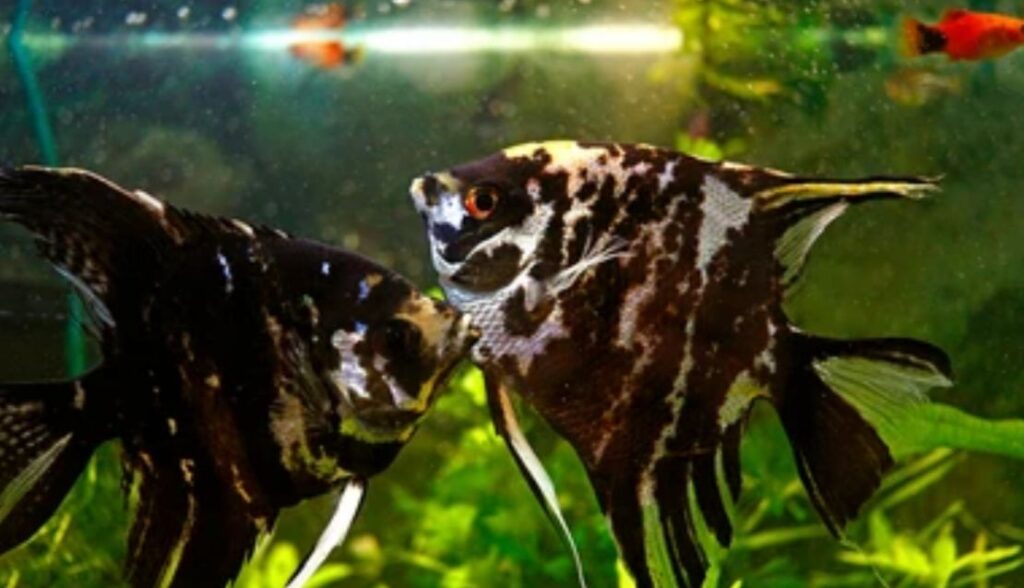
Marble Angelfish Behavior and Personality
Marble angelfishes act calm and are peaceful when they are underage, but slowly they tend to pair up upon getting matured and they get sort of aggressive and territorial. So when they become aggressive they are territorial to the same species members, which they think are dangerous for their territory.
Besides this, they also become aggressive to the other calm or peaceful species, and yes if the other tiny fishes are bite size for them then marble angelfish won’t hesitate on attacking them and will eat them.
So, yes my suggestion is that always keep your small beautiful peaceful fishes in a separate tank and not with marble angelfishes.
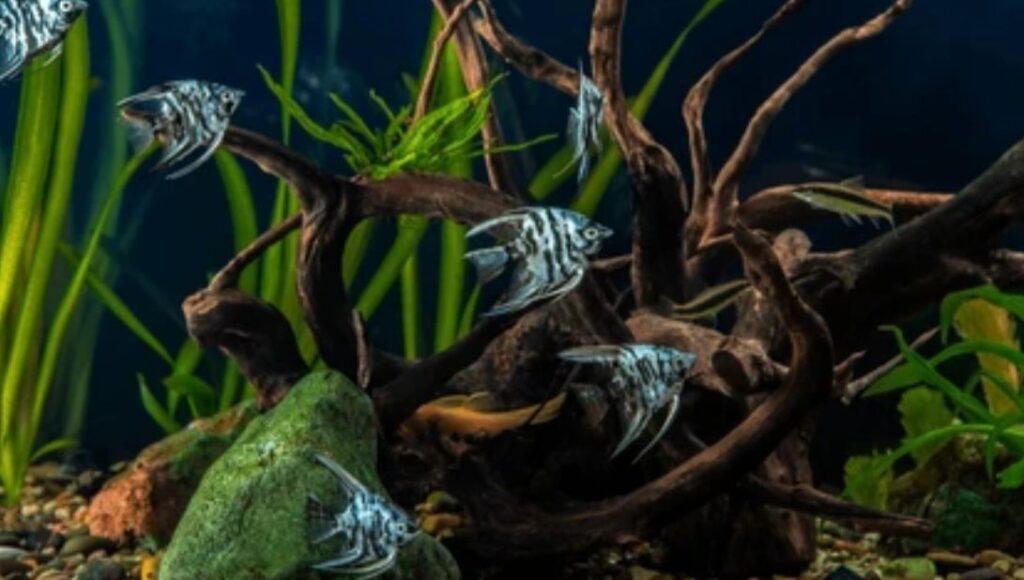
How to Care for Marble Angelfish in Your Aquarium
Care of Marble fish also plays an important role if you are keeping them as your pet. They basically belong to one of the varieties of Scalare fish which means it’s very easy to keep them for both beginners and experts. This makes them the best choice for home tanks.
You don’t have to worry much about them as it’s easy to care for them. The most important thing when it comes to marble angelfish care is their tank water conditions
If you want your marble angelfish to be healthy and happy in your tank, then make sure you have the right water conditions for them and you provide them with a proper food diet.
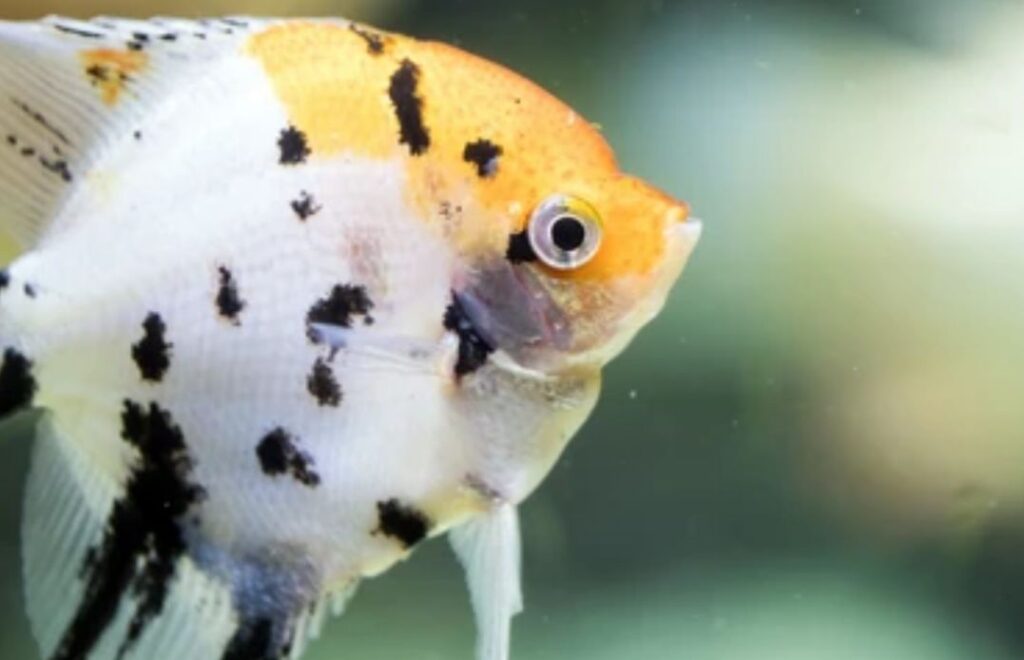
Requirements for Water conditions
Marble angelfish needs a warm aquarium that has a temperature range of 24-38 degrees Celsius. Since they are freshwater fish, they like soft water which has hardness within the range of 2-10 dGH. A slightly acidic environment is best for them. They perform well in the pH range of 6-7.
when Marble angelfish are In their natural habitat, they inhabit areas that have a moderate water current. Because of this reason, water movements in the aquarium should be kept moderate.
Marble angelfish are not at all choosy when it comes to a substrate, but according to my experience, a mixed substrate of sand and gravel in their tank is best for them.
Marble angelfish also require dim light, this is because they are living around vegetation in the wild, where the sunlight is not too strong and it’s on a dim level.
If you fulfill all these requirements for a Marble angelfish tank, then you are good to go.
Marble Angelfish Food and Diet
Food diet also plays an important role in the proper care of marble angelfish. So make sure you are providing them with the proper food which is nutritious for them.
Marble angelfish are omnivorous so basically they like to eat small crustaceans, larvae, insects, and other types of tiny fishes which are easy to eat for them.
I have noticed that sometimes marble is angelfish or you can say occasionally would eat grassy weed as well, which is very good for them as it provides them with nutritions and natural fibers which is important for their health.
When they are in the tank, their diet should include proteinaceous food. They like to eat live as well as frozen foods and they don’t hesitate to eat it.
Best Food for Marble Angelfish
Some of the best foods which Marble angelfish enjoy eating are shrimp-like Mysis shrimp and some vitamin-rich brine. Feeding them with bloodworms is an extra treat for them and marble angelfish will be quite happy after eating it. If you want to maintain a balanced and healthy diet for marble angelfish then you must feed them with pellets, and high-quality flake foods and you must feed them these every day as they are a part of their everyday diet.
Also, I observed and most of my other fish aquarist friends also noticed that Mosquito larvae are the most favorite food item of marble angelfish, and because of this, sometimes, or actually most of the times they overfeed on them. Therefore you must offer them adequately.
Breeding of Marble Angelfish: Tips and Tricks
Nowadays most of the cichlid angelfishes that we see in the tanks are captive inbred and hardly caught in the wild which means they are not coming from lakes, oceans, or rivers.
Since we are talking about marble angelfish, so yeah you are thinking the right thing marble angelfish is also an inbred variety coming from Pterophyllum scalare.
Talking about South American freshwater angelfishes, they naturally make nuclear families when they are paired up. A nuclear family in simple words is a family of a male and a female with sometimes many and sometimes absolutely no children.
They get mature somewhere between 6 to 12 months of their age, but this basically depends on the condition of your tank. But if your tank conditions are completely accurate then they can reach maturity from 5-7 years of age.
For the process of breeding, marble angelfish likes to have clean and clear water in order to spawn. Now let me explain to you the importance of clean water for breeding, so even if they pair up but the water is not completely clean, then they will never ever spawn.
Besides this, you should also maintain a balanced diet that is rich in proteins for them to make the process easier. We have already talked about their food and diet above so make sure you are following it.
Let’s classify the water conditions for them as it is definitely very important to know the ranges before you want them to breed
- The temperature should be between (27 – 29 ° C)
- the pH of the water must be 6.5
- Hardness should be 5 dGH
These conditions are important for the process of spawning. When you are completely satisfied that all the breeding conditions are met, then you will observe that spawning is starting. In this case, the female fish is going to lay hundreds of eggs, the range can be between 100 to 1000 on some flat surface, for example, submerged broadleaf or either branch. After that male fish is going to follow the female and fertilize the eggs.
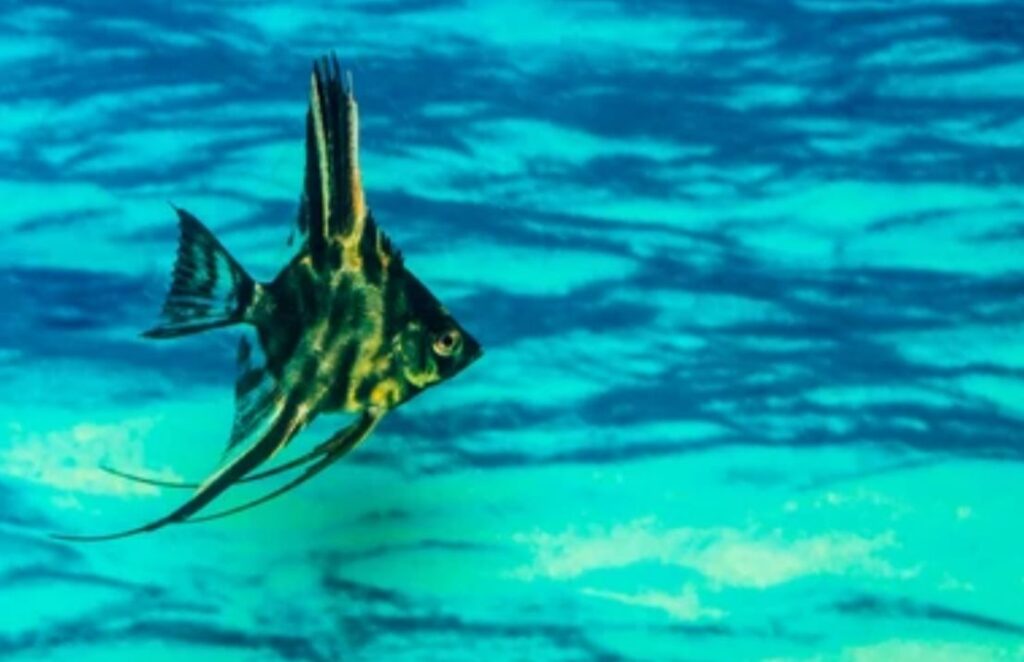
Now the problem is that over the years, the instinctive property to protect the eggs has been completely destroyed because of continuous commercial inbreeding.
The worst thing that can happen is that they can eat their eggs. If you want to prevent this, then you have to provide a spawning surface that resembles a shallow cup or plate-like thing, so you can remove it later and it hatches separately.
Marble Angelfish Tank Requirements
Similarly, like other fishes, marble angelfish also have some specific tank requirements which are very important to follow.
Marble angelfish need a tank that has plenty of swimming places and lots of hiding spaces. It should also have significantly considerable depth.
For a marble angelfish tank, the minimum tank size for a single specimen should be 30 gallons. And if you have a pair, then a 55-gallon tank is recommended for them
A large and deep aquarium is required because marble angelfishes have long dorsal and anal fins, which have the appearance of wings. So you must always prefer the depth of the tank over its length.
Tank Setup
Now let’s talk about their tank setup, The most important thing to remember while setting up their tank is to provide them with the best environment, so they live healthy and happy in your aquarium. As I already mentioned above depth should be always preferred over length.
The ideal marble angelfish aquarium would have length, width, and depth, all in the best proportion. I will make it easy for you to understand.
Their tank must plan plants that have submerged leaves or it should have expanded dense branches around inside peripheries. On the other hand, the rocky formations that makeup crevices should be included and securely stuck with the substrate.
If you are thinking why is it important to have branches or crevices then this is because branches of plants and crevices are the best hiding and resting places for your marble angelfish. But the center of the aquarium must be an open area for swimming so your fish can swim freely.
The filtration system also plays an important role. You must install a good filtration system in order to carry out all types of necessary filtration. This is necessary for preventing or getting rid of the accumulation of nitrates and other harmful toxins.
And for the tank’s bottom, you must provide the substratum, which is going to anchor the plant roots and it will also hook the rockwork securely. The best option is to have a mixed substrate of sand gravels.
Also, we talked about this previously but reminding you all again that marble angelfishes like dim lights. So for this, you should install a lighting system on the roof of the tank.
Marble Angelfish Tank Mates
Let me tell you a little background on them. Cichlid angelfishes basically come from the streams of slow-moving waters or flood plains, which are thickly or densely grown with vegetation that is underwater. Due to this, it becomes home to many angelfish as well as other types of species of fish.
Even though they are sharing a diverse habitat with multiple groups of species, enclosing them in a limited tank that has a very limited space to swim is honestly a completely separate story.
Choosing tank mates for them is not an easy task but don’t worry since we will explain to you everything you need to know about their tank mates.
For choosing their tank mates first of all you have to understand the possible behavioral changes that they can have towards other fish species. I have already mentioned above that these fishes make strong nuclear families. This means that the male fish cannot bear another male’s presence inside their territory, and they will fight for their territory until they die.
Because of this reason, you must keep them alone or in pairs. These are the main rules you have to follow while selecting tank mates for marble angel fish
- Never keep a tiny fish: while choosing tank mates for them don’t choose a fish that is too tiny or is timid and especially if the fish is too small to fit the mouth of marble angelfish because eventually if the fish is too small, your marble angelfish will eat it.
- Semi-Aggressive fish: if you are going to keep semi-aggressive fish with the marble angelfish, then the most important thing is to make sure you have a large tank that has plenty of hiding spots and enough space so they can swim freely. Also, keep an eye on the tank because the long fins of marble angelfish can stimulate the hunting instinct of the other fishes in the tank.
- Aggressive fish: if you are keeping an aggressive fish with them then the predatory fish can hunt down your marble angelfish. So I personally don’t suggest housing them together in one tank.
These are some fishes that go well with marble angelfish
- Bottom-dwelling Khuli loaches.
- Mollies
- Platies
- Freshwater Catfish
- Bolivian rams
- Dwarf Gouramis
Faqs
Where can I purchase Marble Angelfish?
Marble angelfish is basically a fixed form of silver angelfish that is easily available in fish stores and you can also purchase them online.
Marble Angelfish price
The price of Marble Angelfish can vary depending on the size, rarity, and location. Generally, smaller and more common Marble Angelfish can cost around $5 to $10, while larger or rarer specimens can cost upwards of $50 or more.
Conclusion
Marble angelfish basically comes from the genus Pterophyllum. All over the world, they are interbreeding, and this process is basically called captive inbreeding.
Basically, all the freshwater angelfishes that are found in the aquarium trade these days are inbred. Similarly, Marble angelfish is one of the best types of inbred angelfishes. They are further divided into black, blue, and gold varieties.
Marble angelfishes are aggressive fish but still, they are a popular choice among aquarists. So before buying marble fishes make sure that you have a separate tank for them which doesn’t have any timid fishes and their tank mates should be among those who are mentioned above in the article.
Also don’t hesitate to have them as your pet since they are easy to take care of.

